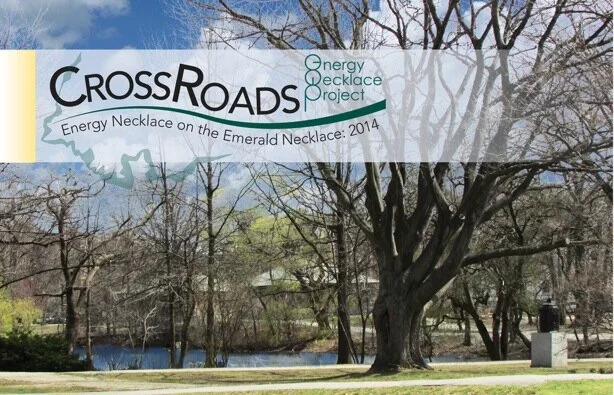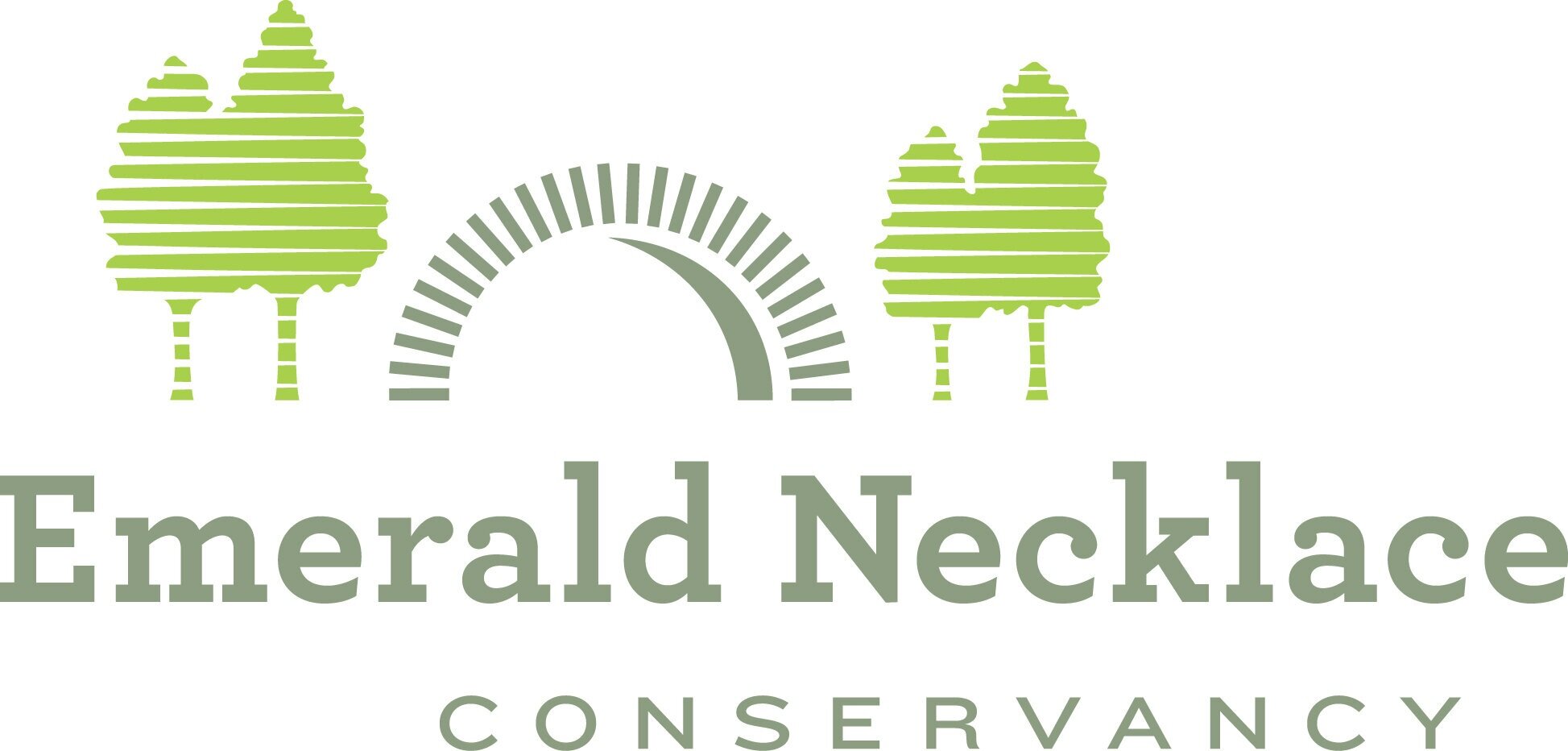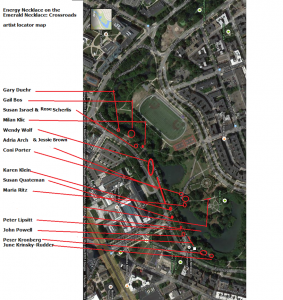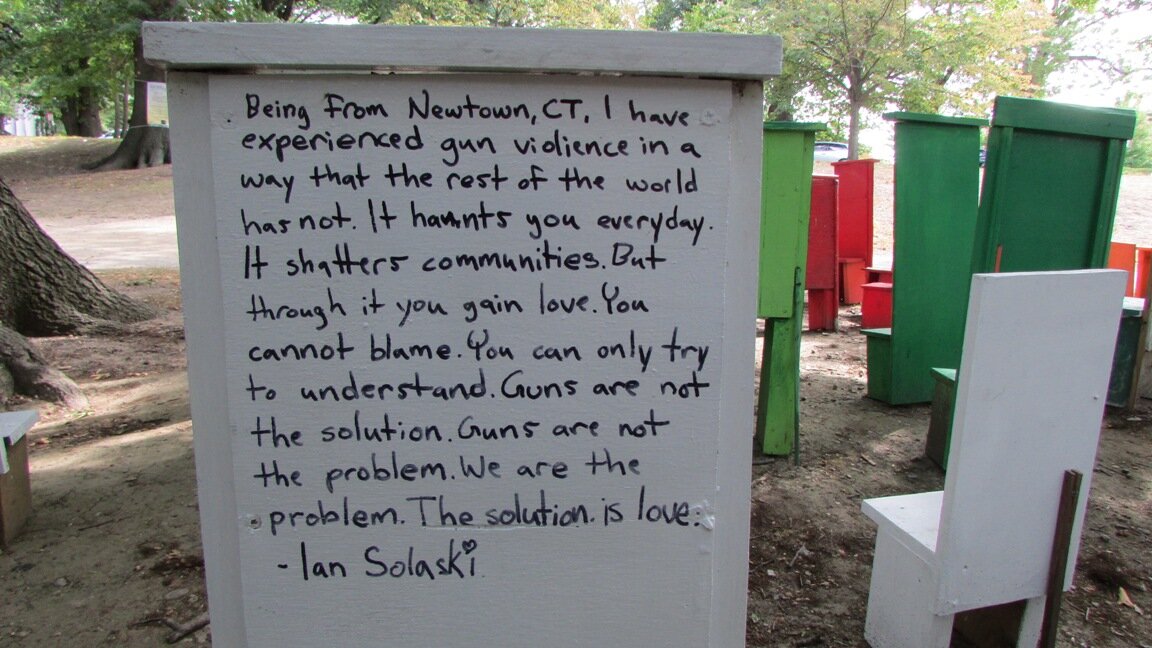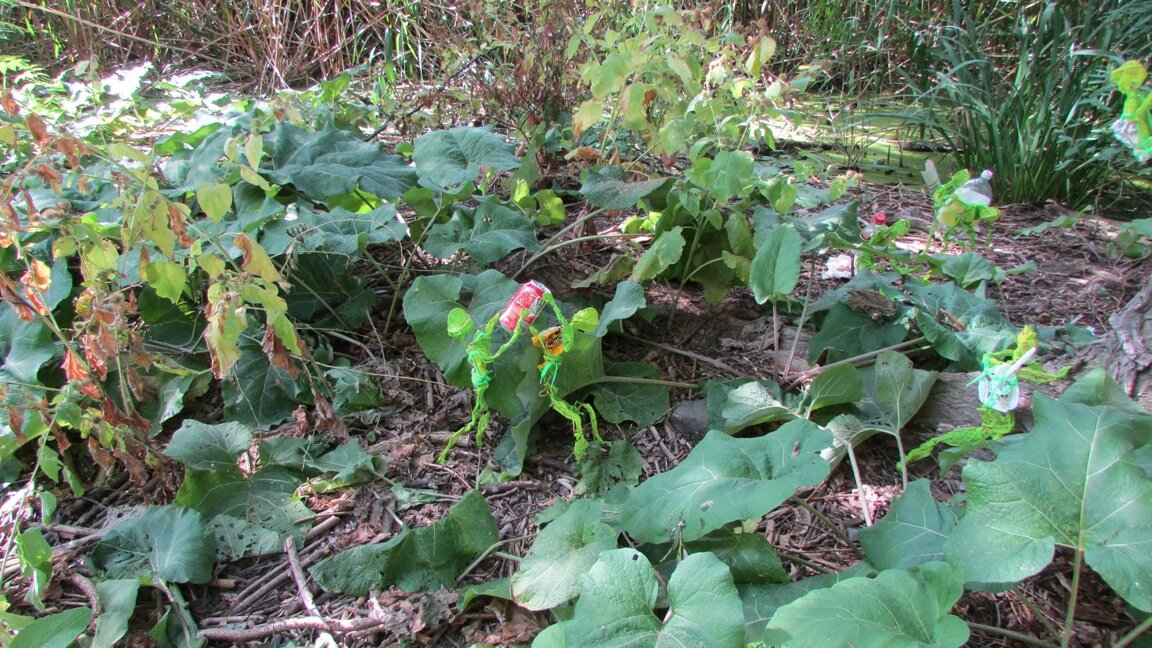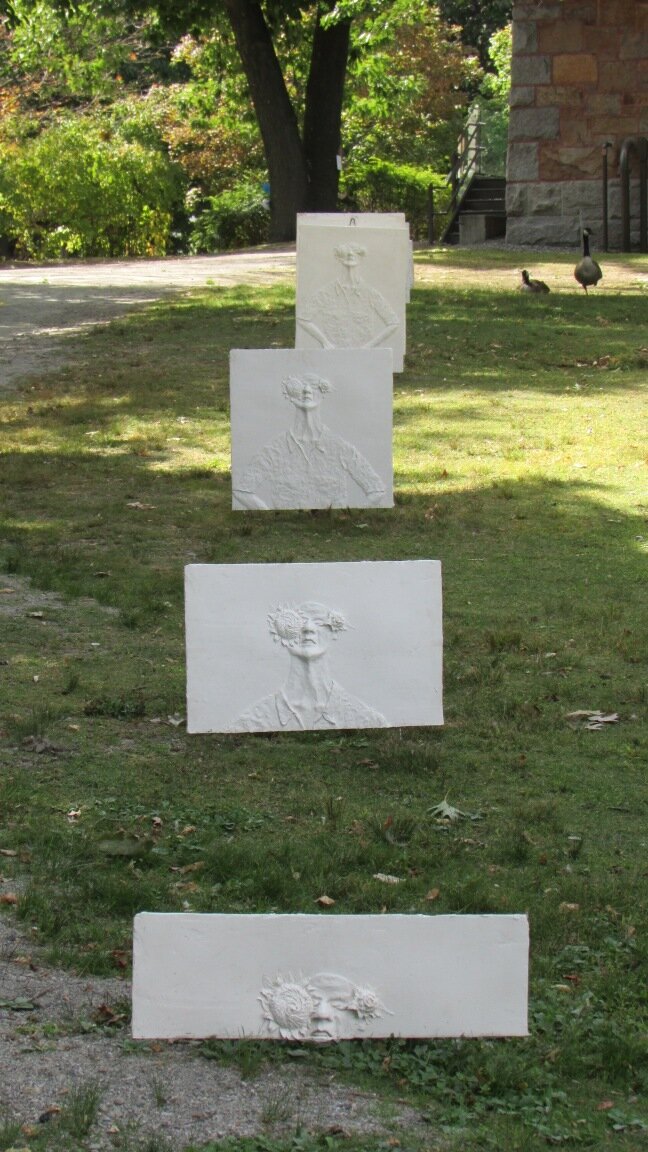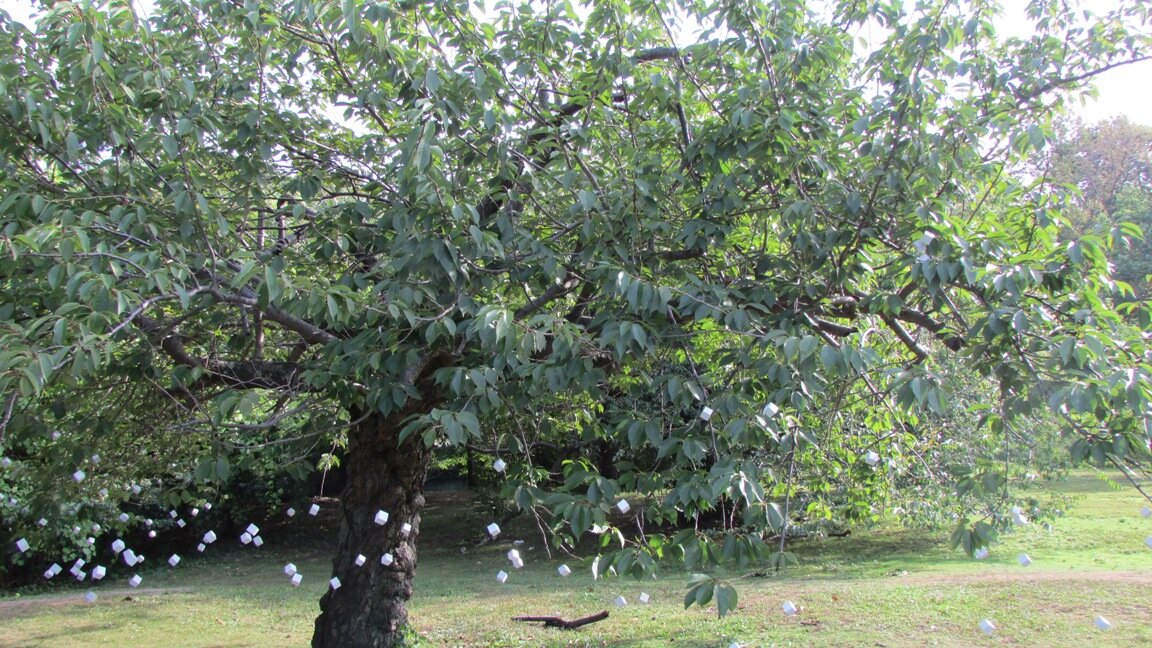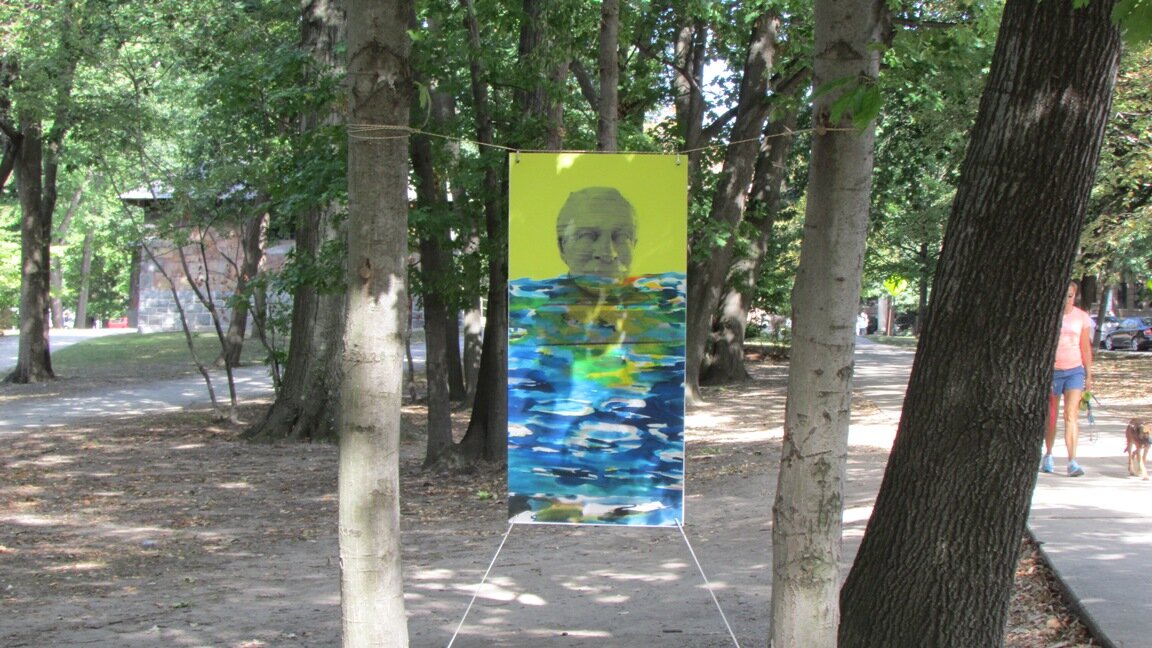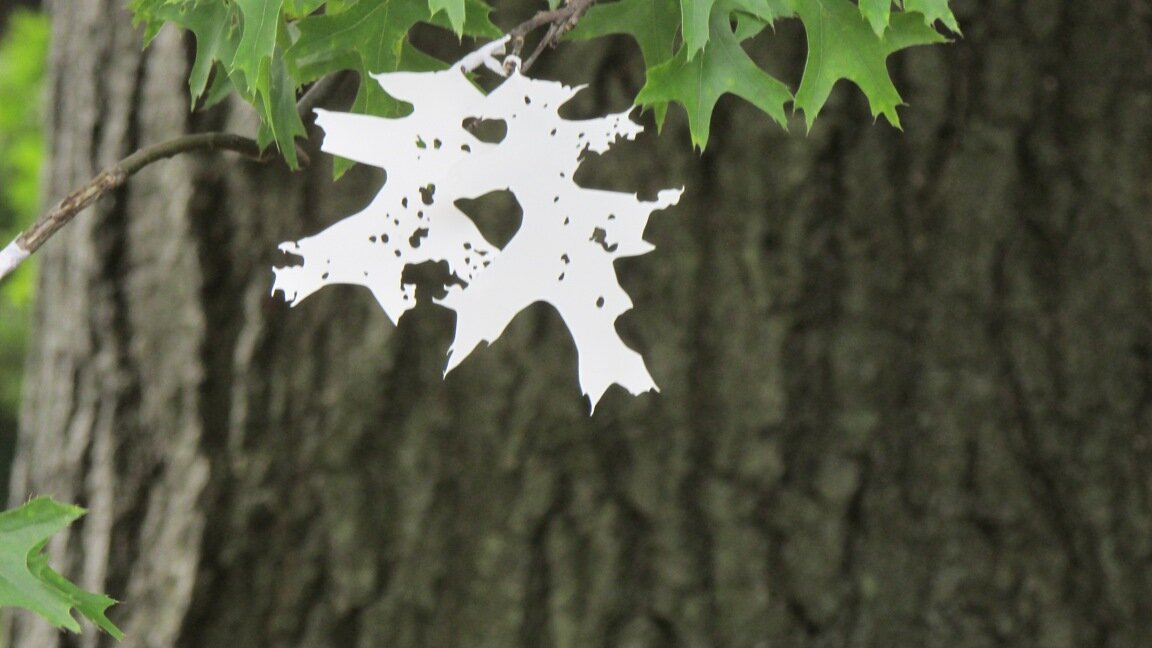September 14 – December 7, 2014
We are at a crossroads with our planet – each day we choose a path forward to make our communities and planet healthier.
14 Temporary site-responsive installations along the Back Bay Fens footpath, hosted by Climate Creatives (previously named the Energy Necklace Project). Facing the Museum of Fine Arts, Boston, from Museum Road to the Shattuck Emerald Necklace Visitor Center.
16 artists, 14 installations
Adria Arch & Jessie Brown, Gail Bos, Gary Duehr, Susan Israel & Rose Scherlis, Karen Klein, Milan Klic, June Krinsky-Rudder, Peter Kronberg, Peter Lipsitt, Coni Porter, John Powell, Susan Quateman, Maria Ritz, Wendy Wolf
Adria Arch (artist) and Jessie Brown (Poet)
Why I Miss the Lost Trees
approx. 60 feet in length, fifteen placards each 18″ x 24″. Commercially printed plastic lawn signs and metal frames.
Plastic lawn signs are ubiquitous in the suburbs. We associate them with unsightly commercialism, advertising everything from political campaigns to pest control services.Using this format, this installation subverts its use as an unwelcome intervention and rather provides an interactive and poetic experience highlighting an emotional response to climate change.
Adria Arch is a mixed media artist whose work features strong graphic elements and vivid color. She combines an abiding interest in shape with a fascination in the
unexpected source. She has recently exhibited her work at Danforth Art, the Art Complex Museum, and in the outdoor sculpture exhibit, Exposed, in Stowe, Vermont.
Jessie Brown is a poet and teacher in the Boston area. In addition to poems and translations in various journals and anthologies, she has two short collections, Lucky and What We Don’t Know We Know. She leads workshops in schools, libraries and community centers, under the auspices of local cultural organizations, and gives performances both in collaboration and alone.
Gail Bos
The Children’s Chair Project
Pine, paint and metal
These chairs were made to reflect the important place children hold in the community. The colors represent the diversity of their backgrounds… some are descendants of those who first lived on this land,others are offspring of parents who came to America from around the world.
The chairs, clustered by color, are set within a large circle as if the children were in school preparing for the future. The 8 red chairs in the center represent the dangers they face. In this case it is the number of children killed by guns each day. As adults we occupy the role of guardians for the children. We know the dangers. We are responsible for their protection.
Gail Bos
Tree Dreams
Each “tree dream” is a 8 ft tall painted board with 12 inch long branches made from decorated cut plywood. These “trees” are attached to living trees with wide packing straps to prevent injury to the living trees. The painted trees are set in small clusters.
Gary Duehr
Sleep Cycle
Cement, 20” x 28” x 6” (3)
Sleep Cycle” questions the nature of sleep and the quality of solitude. The installation is comprised of sculptural pillows made of cement. On each pillow there is handwritten poetic text like a haiku.
- Why Is Sleep Still Here?
- Which House, Silent, Surrounds You?
- What Is The Dark Jealous Of?
Gary Duehr has been chosen as a Best Emerging Artist in New England by the International Association of Art Critics, and he has received an Artist Grant in photography from the Massachusetts Cultural Council. His work has been featured in museums and galleries including the Institute of Contemporary Art, Boston, MA; Exit Art, Umbrella Arts, and New York Arts, New York, NY; Gallery Tsubaki, Tokyo, Japan; SKC Gallery, Belgrade, Yugoslavia; and Museo Nacional de Bellas Artes, Havana, Cuba. Past awards include grants from the LEF Foundation and the Rockefeller Foundation. His public artworks include a photo installation funded by the Visible Republic program of New England Foundation for the Arts, and a commission from the MBTA (Massachusetts Bay Transit
Authority) for a permanent photo installation at North Station. Duehr has written about the arts for journals including ArtScope, Art New England, Art on Paper, Communication Arts, Frieze, and Public Culture. Currently he manages Bromfield Gallery in Boston’s South End.
www.garyduehr.com
Rose Scherlis & Susan Israel
Empty Nests
Wire, fabric, beads; approx. 42” L x 18” W x 10” H
These baskets were made with my oldest child, Rose, when all three of my children were in college. The fabric is from my children’s outgrown clothing, from a past that is irretrievably gone. Our time as individuals is limited, so we must plan for future generations. The metaphor seemed apt for the transition we are facing with our climate. What legacy will we leave future generations?
Susan Israel curated the Energy Necklace at Jackson Homestead in Newton. Her artwork has been in group exhibitions at Flying Horse at Pingree School (in collaboration with Peter Lipsitt), Old Frog Pond Farm, New Bedford Art Museum, Harbor Arts, Studio Without Walls, and other exhibitions.
Rose Scherlis is studying Anthropology at University of Vermont and MassBay Community College. Rose is a writer, and her poems have been published in books and newspapers. She has written for the Somerville News, reporting on the Arts.
Karen Klein
After the Bones
The purpose of After the Bones is to provide aesthetic pleasure and good information. People buy skinless, boneless chicken & turkey, but it is more economical and a better use of food resources to buy meat with the skin on, bones in. After the meat is eaten, bones & skin can be made into stock that can be the base for many sauces and soups, creating more meals & getting more for your money In this installation, specially treated bones from consumed fowl are wrapped in brightly colored threads to catch your attention. Buckets hold laminated recipes for making stock & soups. Viewers are encouraged to take recipes with them & use them at home. As the recipe supply diminishes, the artist will restock the stock.
A retired professor, Karen Klein is a dancer with Prometheus Dance Elders Ensemble & the intergenerational Across the Ages Dance. Her poetry has been published in journals, magazines, & on-line & used in performances of Prometheus Dance Desiderare & in multi-media improvisations at The Uniun, Somerville & The Outpost, Cambridge. She is a member of Galatea Fine Arts, New England Sculptors, & Studios Without Walls. In 2013-14 her installation Tide Tables was shown at the East Boston Marina, and Suggestion Boxes installed at Riverway Park, Brookline.
Milan Klic
Loop of Escapism
Metal, resin and patina structure
Metaphor of mental condition induced to us from childbir th and driving us with deceptive energy, amazingly innovative and alluring, yet fundamentally blinding. We escape from memor y and conscience, we seek consolation in various mirage screens, yet the loop is always there waiting to squeeze the escapist and launch him to another trajectory.
This sculpture is composed to suggest kinetic potential as a ve hicle, but with emphasized dysfunctional features. Wheels are torqued and on the verge of collapse, the path would spiral in and out, loop after loop would spin the consciousness beyond itself. Milan’s story is of an immigrant, cultural fusion, ongoing, never complete. He was bor n and educated in former Czechoslovakia, today’s Czech Republic. At that time the countr y was a part of the communist block and all aspects of culture, visual ar ts in particular, were subject to political dogma and tough censorship. He rec eived a degree in 1974 from Palacky University, Olomouc and began his career as computer programmer. In 1992,
he received a degree in sculpture from Brandeis University. He has shown his work locally and inter nationally, receiving numerous awards, most notably a Pollock-Krasner Grant.
June Krinsky-Rudder
Invasive Species
Dimensions: variable (each figure is approximately 18” tall)
Materials: Mixed Media (coated wire; cheesecloth; latex paint; plastic bottles; aluminum cans, snack, wrappers, etc.)
I originally planned to address the invasive phragmites that can choke off both native plants and the flow of water. Upon viewing the actual site, however, I was struck by the presence of discarded trash in the natural landscape. It reminded me that humans might be the most invasive species of all. Since ‘invasion’ brings to mind military action, I have created a small army of invading infantry, carrying pollution as ants might carry crumbs. My goal is to show that pollution is really an act of war against nature.
June Krinsky-Rudder is an artist and art educator. A co-founder of the East Boston Artists Group, June works and plays with a variety of materials in her studio. Much of June’s subject matter is inspired by water, and what she sees as ‘universal structures’ evident in both microorganisms and the overall composition of the planet. For the ‘Invasive Species’ installation, Ms. Krinsky-Rudder created each figure using wire and mixed media.
Peter Kronberg
Haughty Eyes & Lying Tongue
20” X 42”, Hydrocal
Shown are the first two of a series of Talmud inspired sculptural reliefs. The Rabbis sought to explain the sources of a mysterious skin disease (inaccurately translated as leprosy) that required quarantine and temple sacrifice by ascribing one or more of seven moral lapses to the afflicted. They differ from the seven deadly sins of Christianity in that five have a body part attached. Roughly translated they are:
1. Haughty eyes
2. Lying tongue
3. Hands that shed innocent blood
4. Mind (or brain) that hatches evil
5. Feet that are quick to do wrong
6. Witness that falsely testifies
7. One who incites brothers to quarrel.
Plants, not often seen in sculpture, are used to depict the offensive body part. Feel free to communicate with the sculptor via email: kronberg@rcn.com
Peter Kronberg has made, exhibited and sold figurative and abstract sculpture for over 35 years (starting at age 14). He holds a Bachelor of Fine Arts from the University of Kansas. He studied Architectural Theory at Eidgenossische Techniche Hochschule, Zürich, Switzerland where he failed to interest the faculty in sculptural collaboration. Dismayed, he absconded to the Schnizerschule in Brienze, Switzerland where he studied wood carving fundamentals. He moonlights as a corporate and intellectual property attorney and serves on the adjunct faculty at Tufts University teaching business law. He likes to study Torah.
Peter Lipsitt
Cross + Snarled Ahead
Wood
Humanity tries to find the way over obstacles in unchar ted landscapes with and without a moral compass.
Peter Lipsitt, a longtime Boston artist, has publicly-displayed work occurring this Fall at HarborArts (East Boston), Milton Town Cemetery, Boston City Hall, Pingree School (with Susan Israel in So. Hamilton, MA), Old Frog Pond Far m (Harvard, MA), and permanently at Bajko Rink (Hyde Park, MA) and University Place (Cambridge). www.PeterLipsitt.com
Coni Porter
CO2 Cubed: Choose to Change
Wood, monofilament. 2’ x 2’ x 2’ seated cube, accompanied by a tree full of hanging cubes
Every 10 minutes the average Boston resident releases carbon dioxide equal to the size of a 2’ x 2’ x 2’ cube (at sea level). At twice the world average, we Americans drive our cars, heat and cool our buildings, and consume electricity at unprecedented levels. Our individual actions are pouring greenhouse gas emissions into our lungs, and into our world. This amount of invisible gas becomes very visible as it affects our food sources, our water, and our air. Future predictions of extreme weather events will become commonplace as the climate shifts too fast for the world’s biodiversity to keep up. Question: How many cubes of this size does the average American lifestyle emit over the course of just ONE DAY? Hint: count the cubes hanging from the tree.
Coni Porter is an artist, a graphic designer, and a college professor in the Boston area. She holds an MFA in Interdisciplinary Art and creates public art to share her research into the cause and effect of Climate Change. She believes global warming is the defining issue of this generation.
Susan Quateman
Drowning Arthur Fiedler
Silk painting and photograph of Arthur Fiedler Memorial, Statue printed and adhered onto plexiglass. 20” X 42”
Arthur Fiedler, 1894 – 1979, long-time conductor of the Boston Pops Orchestra, is gradually engulfed by water as sea level rises: a consequence of climate change. As glaciers and ice sheets melt, oceans warm up and sea levels rise, threatening to submerge coastal Boston.
Susan Quateman is a silk painter at Ten Pound Studio, Gloucester, MA, as well as an environmental planner and landscape designer. She has been working on a series of silk paintings and banners on climate change vulnerability and adaptation since November 2013.
Maria Ritz
Plastic Redux
Plastic, zip ties, filament, steel rods; approx. 4’ x 12’
The rings in “Plastic Redux”, assembled into a transparent geometric continuous pattern, recall the hexagonal structure of beehives. But unlike wax, a natural substance, plastic is a petro-chemical by-product, so invasive now in nature that it has started to cross the boundaries between organic and synthetic substances. Oceans are filling up with broken down plastic that mimics plankton particles. The fish eat it, we eat the fish.
Maria Ritz’s work incorporates steel, bronze, stone, glass, as well as organic and recycled materials. Through the combination of these elements she brings into tension a constructivist industrial reality and the fragile but resilient state of nature, a state of equilibrium of which we are all an integral part. She has worked on set design productions with the Underground Railway Theatre in Cambridge and with the International School of Boston, and participated in Public Interactive Art with FigmentBoston since 2008. She is a member of Studios Without Walls and has exhibited annually with them since 2010. In 2013, she installed a large site specific piece for HarborArts at the East Boston Shipyard for the “OccupyING the Present” show, which was reviewed in a number of newspapers and magazines, including the Boston Globe, Artscope Magazine and Sculpture magazine.
She lives and teaches in Cambridge. Contact: www.mcritz.org
Wendy Wolf
Exploring Interconnections: Revealing the Unseen
Cotton thread and hand cut plastic leaves, reproduced from trees at this site
Environmental concerns can develop from the unnoticed impact, and can only be alter ed through recognizing the problem and taking action. I sk the individual to take time within a small part of the environment, to connect reciprocally with a time and place to deeper their understanding of the micro-systems just below the surface. I seek to make them slow down and see in a singular, micro way what people generally see in a macro way as they pass through. I ask people to slow down and see what is there, notice how a tree grows and changes; how two trees can grow into one large one; how a bug can create intricate trails and patterns. I seek to change how a person may forever pass by this place establishing an emotional and physical connection and memory.
Wendy Wolf was born in 1974 in New York State and received her MFA in Printmaking from Tyler School of Art, Temple University in 2003. She currently lives in Newton, MA and maint ains studios in Philadelphia, PA and Waltham, MA. She has exhibited her work nationally, notably at the Inter national Print Center NY, the Danforth Art Museum, a solo show at the George School in Newtown, PA, and in Philadelphia at the Center for Emerging Visual Ar tists, the Independence Seaport Museum. Wendy has completed artist residencies at Taliesin West, CAC at Woodside, and Beechwood Arts. She is currently represented by FitzRoy Knox Gallery in NY and London.
www.thewendywolf.com

